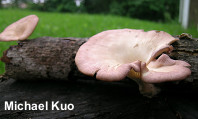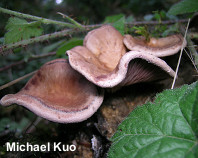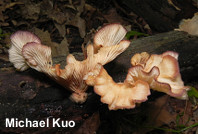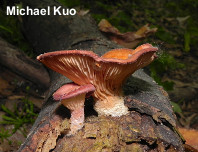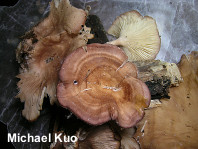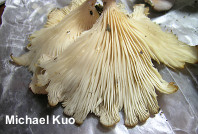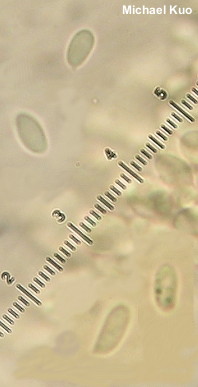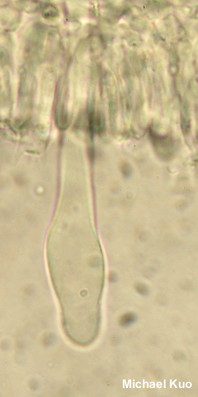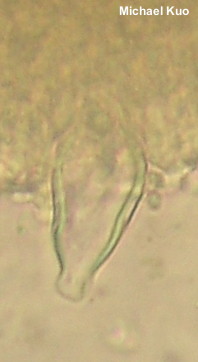| Major Groups > Gilled Mushrooms > Pale-Spored > Pleurotoid Mushrooms > Panus conchatus |

|
Panus conchatus [ Basidiomycota > Polyporales > Panaceae > Panus ... ] by Michael Kuo Panus conchatus is a tough, long-lived wood rotter, recognized by its white spore print, its fairly bald (rather than hairy) cap, and its purplish colors—though the colors eventually fade to brownish or cinnamon brown. The stem of Panus conchatus is almost always fairly well developed, but is usually somewhat off-center or lateral. Despite the presence of gills on Panus conchatus, molecular biologists tell us that it belongs with the polypores, and has evolved with them. If you stop and think about that for a minute, you will see that gills, therefore, came to Panus conchatus independently—completely irrespective of the development of gills in the "gilled mushrooms." But if you are shocked by this example of what is called "convergent evolution," consider that "eyes," depending on how you define them, evolved independently in the animal world 40–60 times! Examples of convergent evolution, however, are not evidence of some Grand Plan in the mind of a Designer; rather, they are merely indications that life on earth is limited by the laws of physics—how gravity, light, temperature (and so on) operate. In other words, an organism's evolutionary options, while not predetermined, are indeed limited by the physics of life on our planet. Thus, successful strategies like "eyes" or "gills" are more likely to occur. Panus torulosus, Lentinus conchatus, and Lentinus torulosus are synonyms for Panus conchatus. Description: Ecology: Saprobic; growing alone or, more frequently, gregariously to clustered, on decaying hardwood sticks and logs; spring through fall, and over winter in warm climates; originally described from France; widespread in Europe but less common in Mediterranean areas; widely distributed in North America from Canada to Mexico but apparently absent or rare in the southern Rocky Mountains; reported from the Caribbean and South America. The illustrated and described collections are from California, Illinois, and Missouri. Cap: 3–12 cm wide; broadly convex at first, but soon developing a central depression or becoming deeply vase-shaped; dry; bald or minutely fuzzy but not prominently hairy; often radially wrinkled; purplish to purplish brown when young, becoming brown to tan or whitish in age but often retaining a purplish margin; often developing concentric zones of color; the colors often breaking up into patches with maturity; the margin inrolled at first, later sometimes becoming scalloped or lobed in places, and faintly lined. Gills: Running down the stem; close or nearly distant; often forking; short-gills frequent; whitish to yellowish or purplish when fresh and young; becoming pale brownish. Stem: 2–8 cm long; 1–1.5 cm wide; tough; often off-center or lateral; equal, or slightly enlarged toward the base; dry; hairy when young, especially toward the base; colored like the cap or paler; basal mycelium white. Flesh: Whitish; very tough; unchanging when sliced. Odor and Taste: Not distinctive. Chemical Reactions: KOH on cap surface negative to slowly greenish yellow. Spore Print: White. Microscopic Features: Spores 4.5–6.5 x 2.5–4 µm; ellipsoid to subcylindric; smooth; hyaline in KOH; inamyloid. Basidia 4-sterigmate. Cheilocystidia 30–50 x 5–7.5 µm; widely cylindric to subclavate or slightly irregular; smooth; thin-walled; hyaline in KOH. Pleurocystidia 25–60 x 5–10 µm; cylindric to widely cylindric, subclavate, or subfusiform; smooth; developing walls up to 2 µm thick; hyaline in KOH. Pileipellis a cutis; elements 2.5–5 µm wide, smooth or very slightly encrusted, clamped at septa, hyaline to brownish in KOH. REFERENCES: (Bulliard, 1787) Fries, 1838. (Fries, 1821; Saccardo, 1887; Kauffman, 1918; Smith, Smith & Weber, 1979; Phillips, 1981; Pegler, 1983; Arora, 1986; Breitenbach & Kränzlin, 1991; Roody, 2003; Grand, 2004; McNeil, 2006; Buczacki et al., 2013; Kuo & Methven, 2014; Desjardin, Wood & Stevens, 2015; Siegel & Schwarz, 2016; Knudsen, 2018; Læssøe & Petersen, 2019; Kibby, 2020.) Herb. Kuo 05250401, 01130507, 04231102, 05171104, 05201801. This site contains no information about the edibility or toxicity of mushrooms. |
© MushroomExpert.Com |
|
Cite this page as: Kuo, M. (2022, March). Panus conchatus. Retrieved from the MushroomExpert.Com Web site: http://www.mushroomexpert.com/panus_conchatus.html |
